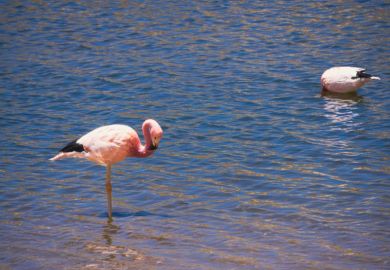Maths and physics tend to be thought of as universal sciences – transcending our own earthly bubble to other solar systems, galaxies and life beyond. But can the same be said for biology? Are our biological laws solely valid for life as we know it? In his new book, Life through Time and Space, Wallace Arthur argues that our biological principles might be more far-reaching than previously imagined.
Arthur is an evolutionary biologist by training, but also has a vast knowledge of astronomy – unconventional partner disciplines that come together in his book to examine how life might begin and evolve in an extraterrestrial environment. The chapters flip between astronomical, evolutionary and developmental arguments for the conditions and processes necessary for life. At the beginning this flip-flopping seems a little confusing and disjointed. As the book progresses, however, it becomes apparent that the aims are to take the reader into a new world (which could be anywhere in the universe) and to explore life beyond our boundaries but not beyond our biology.
The author has a refreshingly jargon-free approach to science writing that feels more conversational than educational. In particular, given his biological background, he explains the astronomy and cosmology at a level that is easily grasped by non-physicists, and indeed by non-scientists. He encourages curiosity and is honest about our limitations: “Maybe a close cousin of the chimpanzee”, as Arthur puts it, “shouldn’t be expected to be able to understand the origins of everything. Maybe, but that won’t stop us from trying.”
The book tackles some immense scientific questions that are beyond our current capability to answer and, despite their complexity, gives the reader a framework to understand and contemplate their significance. A crucial argument is that evolution by natural selection will undoubtedly define the progression of life on other planets. Why? Because given the right ingredients – variation, reproduction and inheritance – natural selection is an inevitable and unstoppable force. This does, of course, require some key assumptions. Yet, given a self-copying mechanism, molecules at the most basic level will evolve; in fact, they can’t not evolve. Because of this, it might be fair to assume that, on an exoplanet that shares many features with Earth, there would be life forms that seem familiar to us, but it is also entirely possible that our Homo -centred view of the universe clouds our creativity in imagining what else could be.
Life through Time and Space takes the reader on a journey through the furthest regions of the universe, but ends with an introverted look at our own species. So far, we are but a blip on the evolutionary tree of life, but it is likely that our intelligence will ensure either our survival or our extinction. Arthur labels intolerance and violence as the two biggest threats to the survival of our species. A world vision is necessary if we hope to bring communities and countries together, so, rather than looking in, perhaps the message should be to look out and to consider what we might look like to someone looking back.
Tiffany Taylor is a research fellow in evolutionary biology at the University of Bath.
Life through Time and Space
By Wallace Arthur
Harvard University Press, 296pp, £23.95
ISBN 9780674975866
Published 25 August 2017
Register to continue
Why register?
- Registration is free and only takes a moment
- Once registered, you can read 3 articles a month
- Sign up for our newsletter
Subscribe
Or subscribe for unlimited access to:
- Unlimited access to news, views, insights & reviews
- Digital editions
- Digital access to THE’s university and college rankings analysis
Already registered or a current subscriber?




